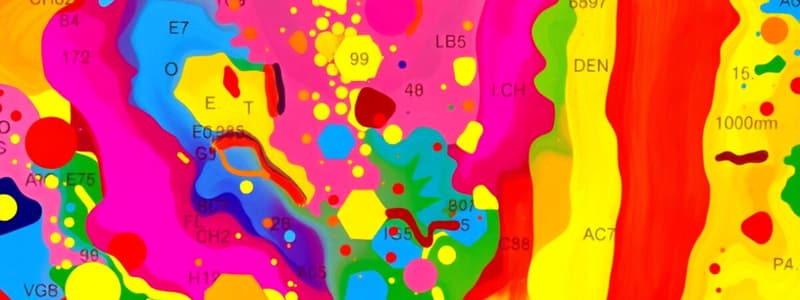Podcast
Questions and Answers
What characterizes isotopes of a given element?
What characterizes isotopes of a given element?
- Different atomic numbers and mass numbers
- Same atomic number but different mass numbers (correct)
- Different chemical properties
- Same number of protons and neutrons
All isotopes of an element have identical nuclear stability.
All isotopes of an element have identical nuclear stability.
False (B)
Name the three isotopes of carbon.
Name the three isotopes of carbon.
C-12, C-13, C-14
The percentage of an isotope in a sample is called __________.
The percentage of an isotope in a sample is called __________.
Match the isotope with its corresponding mass:
Match the isotope with its corresponding mass:
How is the average atomic mass calculated?
How is the average atomic mass calculated?
Carbon has a single stable isotope with an average atomic mass of 12.01 amu.
Carbon has a single stable isotope with an average atomic mass of 12.01 amu.
What tool is used to distinguish isotopes and their abundance in a sample?
What tool is used to distinguish isotopes and their abundance in a sample?
Flashcards
Isotopes
Isotopes
Atoms of the same element that have the same number of protons but different numbers of neutrons.
Isotopic Abundance
Isotopic Abundance
The percentage of a specific isotope in a sample of an element.
Average Atomic Mass
Average Atomic Mass
A weighted average of the masses of all the isotopes of an element, taking into account their respective abundances.
Atomic Number
Atomic Number
Signup and view all the flashcards
Mass Number
Mass Number
Signup and view all the flashcards
Mass Spectrometer
Mass Spectrometer
Signup and view all the flashcards
Molecule
Molecule
Signup and view all the flashcards
Atom
Atom
Signup and view all the flashcards
Study Notes
Isotopes and Average Atomic Mass
- Isotopes are atoms of the same element with the same number of protons but different numbers of neutrons.
- This results in different mass numbers for isotopes of the same element.
- Isotopes have identical chemical properties but often differ significantly in their nuclear stability.
- Many elements are composed of a mixture of isotopes, while others have only one stable isotope.
- Only 80 elements have any stable isotopes..
- Isotopic abundance represents the percentage of a specific isotope in a sample.
- A mass spectrometer is used to identify and measure the isotopic abundance of elements.
- Magnesium is an example of an element with multiple isotopes.
- The isotopic abundance of each isotope in a given element is fixed, meaning the proportion of each isotope is consistent across all samples of that element.
- The average atomic mass listed on the periodic table is the weighted average of all the isotopes' masses.
- The weighted average considers both the mass and the percent abundance of each isotope.
- The isotope with the highest percentage abundance contributes most meaningfully to the average atomic mass.
- Calculating the average atomic mass requires knowing the number of isotopes, the mass of each isotope, and the percent abundance of each isotope.
- Carbon has three isotopes: C-12, C-13, and C-14.
- The average atomic mass of carbon is 12.01 amu.
- Carbon has more than one isotope.
- At least one carbon isotope has a mass greater than 12 amu.
- Carbon-12 is the most abundant carbon isotope.
Calculating Average Atomic Mass
- The formula for calculating average atomic mass is: Average Atomic Mass = (% abundance 1 × mass 1) + (% abundance 2 × mass 2) + ... + (% abundance n × mass n)
Studying That Suits You
Use AI to generate personalized quizzes and flashcards to suit your learning preferences.




